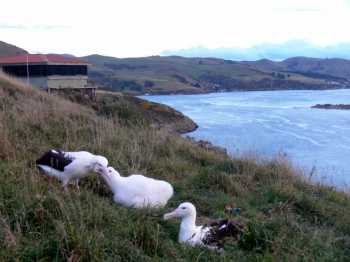Trapping of introduced predators takes place year round within the mainland breeding colony of globally Endangered Northern Royal Albatrosses Diomedea sanfordi at Taiaroa Head at the end of New Zealand's Otago Peninsula. Since the start of the current breeding season on 1 October last year totals of 53 rats Rattus sp., nine Stoats Mustela erminea, one Ferret M. putorius furo and two feral cats Felis catus have been trapped.
“We use kill traps baited with rabbit or hen’s eggs. There has been year-round trapping effort here since 1967 and seasonal trapping effort since the 1940s. This makes Taiaroa Head trapping one of the longest running trapping programmes in New Zealand” (click here).

A Northern Royal Albatross family at Taiaroa Head, photograph by Junichi Sugushita
Unlike albatross breeding sites on the Hawaiian island of Oahu, Taiaroa Head is not protected by a predator-proof fence. However, a fence does halt entry by humans, domestic dogs and European Rabbits Oryctolagus cuniculus, although cats, Stoats, Ferrets and rats are able to climb over it. As previously reported by ACAP Latest News a predator-proof fence would need to be 600-m long to extend across the neck of the headland and would have to have a self-closing gate allowing both vehicle and pedestrian access (click here).
John Cooper, ACAP Information Officer, 05 April 2018

 English
English  Français
Français  Español
Español